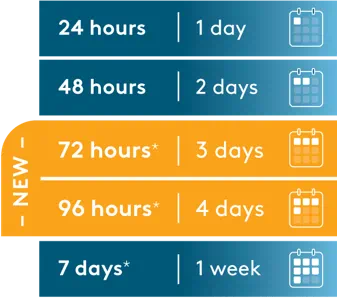References: 1. BLINCYTO® (blinatumomab) prescribing information, Amgen. 2. Litzow MR, Sun Z, Mattison RJ, et al. Blinatumomab for MRD-negative acute lymphoblastic leukemia in adults. N Engl J Med. 2024;391:320-333. 3. Litzow MR, Sun Z, Paietta E, et al. ECOG-ACRIN-E1910 NCTN clinical trial: A phase III randomized trial of blinatumomab for newly diagnosed BCR-ABL-negative B lineage acute lymphoblastic leukemia in adults. Presented at: 64th ASH Annual Meeting and Exposition; December 10–13, 2022; New Orleans, LA. 4. Dinner SN, Sun Z, Paietta EM, et al. Addition of blinatumomab to consolidation therapy for younger adults (< 55 years) with newly diagnosed BCR:ABL1-negative B-acute lymphoblastic leukemia (ALL) on the ECOG-ACRIN E1910 phase III trial. Presented at: 30th European Haematology Association Congress; June 12–15, 2025; Milan, Italy. 5. Gupta S, Rau RE, Kairalla JA, et al. Blinatumomab in standard-risk B-cell acute lymphoblastic leukemia in children. N Engl J Med. 2025;392:875-891. 6. Data on file, Amgen; 2024. 7. Rau R, Gupta S, Kairalla J, et al. Blinatumomab added to chemotherapy improves disease-free survival in newly diagnosed NCI standard risk pediatric B-acute lymphoblastic leukemia: Results from Children’s Oncology Group Study AALL1731. Presented at: 66th ASH Annual Meeting and Exposition; December 7–10, 2024; San Diego, CA. 8. Gupta S, Rau RE, Kairalla JA, et al. Blinatumomab in standard-risk B-cell acute lymphoblastic leukemia in children. N Engl J Med. 2025;392(suppl):875-891. 9. Referenced with permission from the NCCN Clinical Practice Guidelines in Oncology (NCCN Guidelines®) for Acute Lymphoblastic Leukemia V.2.2025. ©National Comprehensive Cancer Network, Inc. 2025. All rights reserved. Accessed August 11, 2025. To view the most recent and complete version of the guideline, go online to NCCN.org. NCCN makes no warranties of any kind whatsoever regarding their content, use or application and disclaims any responsibility for their application or use in any way. 10. Referenced with permission from the NCCN Clinical Practice Guidelines in Oncology (NCCN Guidelines®) for Pediatric Acute Lymphoblastic Leukemia V.1.2026. © National Comprehensive Cancer Network, Inc. 2025. All rights reserved. Accessed August 13, 2025. To view the most recent and complete version of the guideline, go online to NCCN.org. NCCN makes no warranties of any kind whatsoever regarding their content, use or application and disclaims any responsibility for their application or use in any way.










